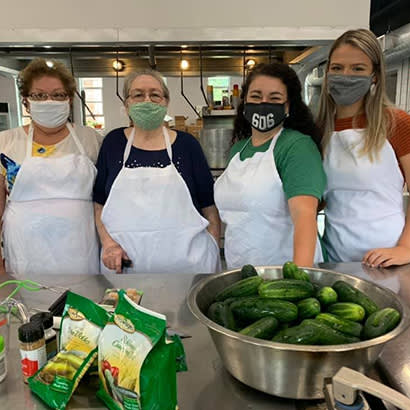Local park and recreation agencies serve as Community Wellness Hubs. In this role, park and recreation agencies provide vital programs and services that address the diverse health and wellness needs of all people, including promoting access to healthy food. Food insecurity remains one of the greatest public health issues nationwide with more than 38 million people, including 12 million children, in the United States experiencing food insecurity. People who are Black, Latino, Native American, and people who live in rural communities experience food insecurity at higher rates due to systemic barriers to healthy food and other social determinants of health including healthcare, housing, jobs, education and safe and healthy environments. The coronavirus (COVID-19) pandemic, coupled with continued socioeconomic challenges across the globe, has also increased the number of people experiencing food insecurity. According to Feeding America, 60 million people turned to food banks and other community programs in 2020 to help put food on the table. Local park and recreation agencies are helping address the root causes of hunger, while working to connect children, adults and families to needed social resources.
Park and recreation agencies serve as one of the leading providers of healthy meals and nutrition education to children and families. Through the U.S. Department of Agriculture federally funded child nutrition and older adult programs 47 percent of agencies provide nutrition education and 37 percent of agencies provide meals. In alignment with NRPA’s Community Wellness Hub vision and building off the existing food security efforts across the park and recreation field, park and recreation professionals are advancing and integrating new approaches to increase community-wide access to healthy food. This includes supporting community access to sustainable, federally funded nutrition programs like SNAP and WIC.
SNAP and WIC in Parks and Recreation
SNAP is the federal abbreviation for the Supplemental Nutrition Assistance Program, formerly known as food stamps. SNAP provides eligible individuals with nutrition benefits via an Electronic Benefits Transfer (EBT) card to supplement the food budget of families and support them in purchasing food for self-sufficiency. This card can be used like a debit card to purchase eligible food in authorized retail food stores, farmers markets or other grocery providers.
WIC stands for the Special Supplemental Nutrition Program for Women, Infants and Children. WIC provides supplemental foods, healthcare referrals and nutrition education to eligible low-income pregnant and postpartum women and children under five. While SNAP and WIC are federal programs, they are administered at the state level and program benefits can vary by state. Refer to your state health office for relevant information regarding eligibility and benefits for your community (see the sidebar for more information).
Federal programs like SNAP and WIC are designed to support food security and eliminate barriers to accessing healthy food. Transportation, time and stigma are all significant barriers for eligible individuals to enroll in nutrition assistance programs. The Food, Research and Action Center (FRAC) shares that there is a national 18 percent gap between individuals who are eligible for SNAP and individuals who receive SNAP benefits. FRAC provides the following reasons for this participation gap:
- Without knowledge of the eligibility criteria, eligible individuals may not even realize that they qualify for benefits.
- Applications or interviews may not be conducted in the applicant’s native language, making the process more difficult.
- Potential beneficiaries may lack the phone, internet or vehicle access necessary for filling out an application, providing copies of identification or completing interviews with benefits staff.
- The trauma of systemic discrimination can foster a sense of distrust toward government among historically marginalized communities, deterring them from reaching out for government assistance.
- Older individuals and those with disabilities may have particular barriers.
The participation rates for WIC are even lower with only 57 percent participation from the eligible population. While rates of Medicaid participation have increased by 16 percent from 2020 to 2021, WIC participation only grew by 3 percent.
Given the sustainability of these programs and the direct impact it can have on households, SNAP and WIC are critical programs to promote through community-based organizations working to improve health and social outcomes. While still a relatively new concept to parks and recreation (only fourteen percent of agencies provide SNAP and/or WIC enrollment services according to the 2021 Advancing Community Health and Well-Being report), the urgent and growing needs created by the COVID-19 pandemic and the expanded role that park and recreation agencies are playing as Community Wellness Hubs has spurred some innovative initiatives, programs and partnerships across the field to promote access to SNAP and WIC benefits.
 NRPA developed the online toolkit — Supporting SNAP and WIC Outreach: A Toolkit for Park and Recreation Professionals — to provide information and resources park and recreation professionals need to make the case for integrating food assistance programs into their spaces. This SNAP and WIC Outreach Toolkit compiles guidance, support and promising practices for professionals in the field to provide SNAP/WIC outreach directly to community members, connecting them to enrollment and retention assistance for increased access to affordable and healthy foods.
NRPA developed the online toolkit — Supporting SNAP and WIC Outreach: A Toolkit for Park and Recreation Professionals — to provide information and resources park and recreation professionals need to make the case for integrating food assistance programs into their spaces. This SNAP and WIC Outreach Toolkit compiles guidance, support and promising practices for professionals in the field to provide SNAP/WIC outreach directly to community members, connecting them to enrollment and retention assistance for increased access to affordable and healthy foods.


